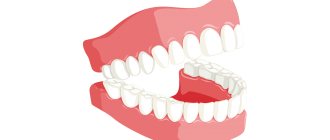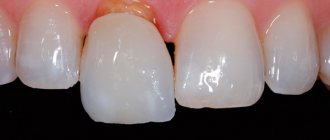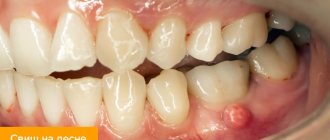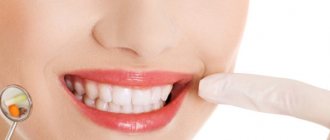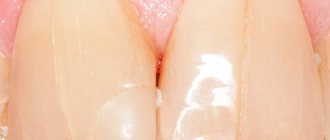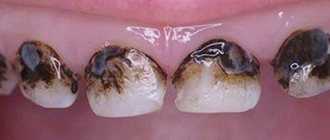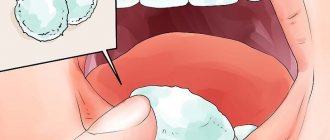A chipped tooth is one of the most common mechanical damage to the dentition; also, the breaking off of a part of a tooth can be caused by a decrease in the strength of dental tissues due to various diseases of the oral cavity. Decay of teeth, especially those located in the front part, reduces the aesthetics of a smile, so most often people try not to put off visiting the dentist. However, there are injuries that are not very noticeable at first, especially if they are not accompanied by pain, and if a tooth injury is left to chance, this can lead to unpleasant consequences.
Chipped front tooth
Dental tissue is the hardest surface in the entire body, consisting of 96% inorganic substances, 3% water and only 1% organic materials. Despite the fact that the composition of tooth enamel does not contain collagen, it contains other protein compounds, for example, enamelins and amelogenins. Dental tissue is wear-resistant and highly durable, and the top layer of enamel can reach 2.5 mm, but for all its advantages, it has a serious drawback - the inability to regenerate, so over time the tooth surface becomes thinner and there is a risk of chipping.
For modern dentistry, there is very little that is impossible, and repair of a chipped tooth can be done quickly, efficiently and effectively in our clinic, where the most highly qualified specialists and real luminaries of medicine work. And in order for our patients to be armed with information and ready for anything, we will tell you in detail about what causes a tooth fracture, what treatment methods exist and how to restore a chipped tooth.
Causes of dental chips
There are many circumstances that can lead to partial tooth destruction; among the most common, experts note the following:
- Injuries received by mechanical means, from which people who lead an active lifestyle or choose extreme sports are least insured (children jumping like saigas and teenagers fighting behind garages also fall into this category). Although, by and large, this reason is quite common, tooth damage can be caused by blows, falls, accidents, which, unfortunately, happen every day.
- Demineralization of tooth enamel, lack of calcium, fluoride and other microelements necessary to strengthen teeth are typical for women during pregnancy and lactation, and the elderly.
- Weakening of enamel due to overuse of sweet or sour foods, viscous and hard foods, exposure to high and low temperatures is at risk for those with a sweet tooth, especially those who like to drink ice cream with hot coffee.
- Carious lesions of the enamel of dental tissue, which can penetrate to the very root and significantly reduce the strength of the tooth, making it fragile and unstable even to small loads.
- An incorrect bite that disrupts the balance of stress on the dentition, which can lead to the abrasion of enamel and the appearance of areas with exposed dentin.
- Disturbed hormonal metabolism, weakened immunity, poor heredity.
- Bad habits, such as heavy smoking, the habit of cracking nuts with your teeth or opening beer bottles with your teeth like a hussar.
- Poor installation of the seal or its destruction.
Child's tooth chipped
Types of damage and consequences of chips
Chip of tooth enamel or microcrack
As a result, the integrity of the upper dental layer is compromised, or its particles are separated. In most cases, such damage is barely noticeable and does not cause pain to the person; experts classify these defects as mild, and people prefer not to go to the dentist with such “nonsense.” However, places where the integrity of the enamel is damaged may be subject to various stresses, which provoke the development of pathogenic microflora, carious lesions and the activity of pathogenic microorganisms.
Vertical and horizontal cracks
Chipped tooth with dentin fracture
Considered to be a moderate injury. Such damage may not be accompanied by pain, or may cause discomfort and unpleasant sensations to external stimuli: hot or cold food, sour or sweet foods. Dentin is the inner tissue of the tooth and is inferior in strength to enamel, therefore, if the lost part is not built up in time, the dentin will begin to crumble, which can lead to tooth loss. From an aesthetic point of view, even a small chip in a front tooth can significantly reduce the attractiveness of your smile.
Deep fracture of the tooth to the pulp tissue with exposure of the nerve
This type of injury is considered the most severe, often accompanied by a split tooth into two parts, profuse bleeding and sharp pain, reminiscent of the torture of the Spanish Inquisition, and even painkillers only temporarily dull the pain. In such cases, delay can be fraught with inflammation and the development of infection.
Complications
A chipped tooth is a kind of “bell” that reminds you that not everything is in order in the mouth. As a rule, after an examination, the dentist discovers advanced caries and a thick layer of tartar. In the absence of timely measures, bacteria and microbes settle on the surface of the fracture, which penetrate into the pulp and then into the root canals. In a few months, they can completely “eat” the tooth - the bone tissue becomes loose and therefore cannot be restored.
When tissues are injured by the sharp edges of broken teeth, cysts and granulomas often arise in which pus accumulates. In such a situation, it is not far from sepsis - surgical treatment and long-term therapy will be required.
What should you do first if a tooth is damaged?
Of course, if you receive slight damage to the enamel or detect microcracks, you should not escalate the situation and immediately run to the 24-hour dental care office; just make an appointment with the dentist on any convenient date. But in case of moderate or severe tooth defects, it is necessary to consult a doctor as soon as possible, having first provided first aid to yourself.
Cold compress for a damaged tooth
To do this, you need to rinse your mouth with a saline or soda solution to remove any remaining food, in case of serious damage, apply a cool compress that will prevent swelling, and in case of gum injury, use a disinfectant pad with hydrogen peroxide. If the pain is severe and there are no contraindications, a painkiller will come to the rescue. And then – straight to the doctor!
Restoration of a chipped tooth: types of treatment and restoration of damage
In restorative dentistry, various methods of tooth restoration are used, depending on the type of injury, the nature of the defect, the location of the damaged tooth and the general health of the patient. In each specific clinical case, the method of tooth restoration is determined individually, but experts identify several main types of treatment for chipped teeth.
Remineralization
Remineralization is used as a method of partial restoration of tooth enamel with small defects and microcracks, for prophylaxis, to prevent the leaching of minerals and to strengthen the outer layer of the tooth. The surface is covered with a special solution containing micronutrients and enriched with minerals. Remineralization allows you to restore the protective properties of enamel.
Remineralization of tooth enamel
Fluoridation
Fluoridation is the application of medicinal preparations in the form of gels and varnishes with a high fluorine content to the damaged surface. The procedure is carried out in several stages and allows you to restore the integrity of the enamel in case of minor damage.
Building up
Extension is carried out in cases of moderate tooth trauma with partial dentin fracture; the procedure involves applying a special medical paste, fixing each layer using light radiation. When restoring in this way, a certain texture, color and shade of the building material is selected, which makes it possible to make the restored tooth practically indistinguishable from others. This technique has a relatively low cost and is effective, which has made extensions very popular.
Filling and microprosthetics
Filling and microprosthetics are used for extensive damage to dental tissue; in various cases, restoration is used using conventional fillings, stump and restoration inlays, veneers and lumineers, and in case of tooth loss, prosthetics on implants or the installation of artificial crowns are performed.
Microprosthetics of cracked teeth
For outgoing and public people, the appearance and attractiveness of a smile is often of great importance, so a chipped front tooth can become a real problem. For the restoration of teeth located in the frontal part of the dentition, onlays made of ceramics, porcelain or zirconium dioxide can be used, which are the best aesthetic solution. When using microprosthetics with veneers, you have to grind off a thin layer of enamel to make the overlay look as natural as possible; the procedure is quite unpleasant, but allows you to achieve maximum attractiveness. Lumineers are thinner, so their installation does not require grinding the enamel, but this type of lining is more vulnerable to mechanical damage. Onlays perfectly hide tooth defects and are used not only in case of chips, but also to restore aesthetic function to patients with crooked dentition and large gaps between teeth.
When restoring lateral teeth that are hidden from the eyes of others, visual appeal and beauty often fade into the background, so restoration can be performed using inlays, the main task of which is to reconstruct the integrity of the tooth and restore chewing function. Restorative inlays perform the same function as fillings, but for more extensive damage - they replenish the damaged or chipped part of the tooth, restore the original shape and relief of the dental unit. Stump inlays work on the principle of crowns - they restore the upper part of the tooth, which has preserved the root and base, but has a large affected area. Inlays are made from noble and base metals, metal alloys, which makes them wear-resistant and durable, and ceramic, metal-ceramic and light-polymer composite inlays are used to restore the color and shade of teeth. In some clinical cases, adhesive microprostheses made of fiberglass in the form of a beam can be used, which are attached to notches on adjacent teeth using medical cement; such products are hypoallergenic, light and durable.
Installation of crowns
Very often, patients are interested in whether it is possible to build up a tooth with a vertical crack and a damaged nerve, split in half to the pulp. Despite the wide arsenal of restoration methods, the most acceptable option is the removal of the injured tooth with the subsequent installation of an implant and an artificial prosthesis.
A child's baby tooth is chipped: do children get teeth augmented?
Children, due to their activity and curiosity, are susceptible to injuries, which can lead to the formation of chips on their teeth; in addition, in older children, the bite changes, single molars grow, which can lead to an uneven load on the milk teeth, which can lead to weakening of the enamel and the formation of cracks. Many adults mistakenly believe that such defects should not be treated, since baby teeth will fall out anyway.
If treatment for damage to baby teeth is not started in time, in addition to pain and increased sensitivity, the child may develop stomatitis, so it is necessary to visit a dentist in case of injury.
As a rule, the treatment of primary teeth occurs according to a simplified system in order to preserve temporary units before they fall out; antiseptic protective gels, fluoridation or installation of a temporary plastic filling are used to protect the tooth from further destruction.
Prevention
To prevent chipping of hard tissues, you must adhere to the following rules:
- do not neglect daily cleaning and other hygiene procedures;
- visit the dental clinic every six months for preventive examinations;
- promptly treat caries and other diseases;
- adhere to a proper balanced diet;
- lead a healthy lifestyle, eliminate bad habits;
- if the bite is broken, take measures to correct it;
- minimize the risks of traumatic effects (too hard food is one of the main reasons why a piece of a back tooth breaks off, an incisor or a fang breaks off);
- periodically resort to professional cleaning to remove plaque and stone;
- consult a doctor even if microcracks appear that are not accompanied by unpleasant symptoms.
The dentition is a vulnerable place, especially if you neglect hygiene rules, often chew caramel, smoke, ignore oral diseases and make other mistakes. Chips of the enamel and deeper tissues often lead to serious complications if restoration is not started in time. Before determining what to do if a piece falls off or half of a tooth breaks off, the doctor must determine the extent of the damage and decide whether it is possible to restore the dental unit without resorting to the last resort - extraction.
What can happen if treatment is not started on time?
For some, it may seem that a chipped tooth is not such a serious defect to pay attention to it; for some people, the aesthetic component and beauty of a smile does not play a significant role, while others are willing to endure such inconveniences as increased tooth sensitivity only would not visit the dentist. However, if you ignore the problem, it can lead to more serious consequences:
- The appearance of carious lesions with damage to dentin and the formation of cavities in the tooth. In advanced cases, caries is complicated by pulpitis and periodontitis. The affected tissue not only causes severe pain, but also leads to extensive destruction, including tooth loss.
- Development of cysts and granulomas
- Displacement and shifting of the dentition due to curvature of the roots or changes in the angle of inclination of the root; the most harmless thing this can lead to is malocclusion.
The occurrence of caries at the site of tooth damage
Most of these diseases are quite difficult to treat, so you should respond promptly to emerging oral problems and not neglect medical care, so as not to become a regular client of the dentist.
Selecting a recovery method
This function is performed by the doctor, taking into account the volume and nature of the injury.
Even with global tooth destruction, when only the root remains, successful restoration is possible.
In these cases, extensions (prosthetics) are used, since a regular filling cannot be used.
To carry out restoration, several conditions must be met:
- There should be no acute inflammatory processes in the oral cavity;
- The bite must be correct;
- The presence of cysts, caries and granulomas is unacceptable.
Recommendations from experts
It is impossible to completely exclude the possibility of the formation of dental defects, but in order to minimize the risk of cracks and chips in the teeth, experts recommend following a few simple rules that will help strengthen tooth enamel and make it more resistant to mechanical damage:
- Pay close attention to your oral hygiene, don’t be lazy about brushing your teeth twice a day, and don’t shy away from using dental floss and mouthwash.
- If possible, limit yourself to consuming sugary edibles. Of course, many people love cakes, sweets and ice cream, but everything should be in moderation!
- Include in your daily diet foods rich in fluoride, calcium, phosphorus and vitamin C: natural milk, sour cream, kefir, fermented baked milk, cottage cheese, various types of cheeses, herbs and nuts.
- Visiting the dentist at least twice a year, a timely scheduled examination makes it possible to identify most oral diseases at an early stage.
Repairing chips on artificial teeth
Unfortunately, no one is immune from injury, so there is a possibility of damage to artificial teeth, for example, temporary metal-plastic crowns, ceramic products (in cases of high load on them) or metal-ceramic crowns. In such cases, the product can be polished, removed with subsequent repairs, or an artificial crown can be built up directly in the oral cavity using special materials - silane, opaque composition and a halogen lamp.
Polishing artificial teeth
Symptoms
The symptoms of a chipped tooth are as follows:
- The functions of the dentofacial apparatus are impaired.
- Cracks are visible on the enamel.
- Filling falling out.
- The tooth is open, the nerve endings are exposed.
- The dental crown is broken.
In addition, the person suffers from pain and severe sensitivity. The sensation of strong or weak pain depends on the nature of the chip. A broken piece usually results in a reaction to temperature changes.

